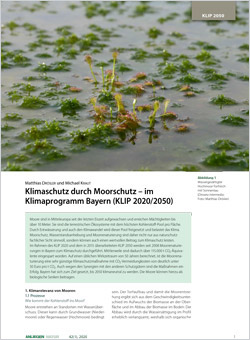Klimaschutz durch Moorschutz – im Klimaprogramm Bayern (KLIP 2020/2050)
Matthias Drösler und Michael Kraut
Klimaschutz durch Moorschutz – im Klimaprogramm Bayern (KLIP 2020/2050)
Moore sind in Mitteleuropa seit der letzten Eiszeit aufgewachsen und erreichen Mächtigkeiten bis über 10 Meter. Sie sind die terrestrischen Ökosysteme mit dem höchsten Kohlenstoff-Pool pro Fläche. Durch Entwässerung und auch den Klimawandel wird dieser Pool freigesetzt und belastet das Klima. Moorschutz, Wasserstandsanhebung und Moorrenaturierung sind daher nicht nur aus naturschutzfachlicher Sicht sinnvoll, sondern können auch einen wertvollen Beitrag zum Klimaschutz leisten. Im Rahmen des KLIP 2020 und dem in 2015 überarbeiteten KLIP 2050 werden seit 2008 Moorrenaturierungen in Bayern zum Klimaschutz durchgeführt. Mittlerweile sind dadurch über 115.000 t CO2-Äquivalente eingespart worden. Auf einen üblichen Wirkzeitraum von 50 Jahren berechnet, ist die Moorrenaturierung eine sehr günstige Klimaschutzmaßnahme mit CO2-Vermeidungkosten von deutlich unter 50 Euro pro t CO2. Auch wegen den Synergien mit den anderen Schutzgütern sind die Maßnahmen ein Erfolg. Bayern hat sich zum Ziel gesetzt, bis 2050 klimaneutral zu werden. Die Moore können hierzu als biologische Senken beitragen.
Summary
Climate Protection through Moor Protection – in the Climate Program Bavaria (KLIP 2020/2050)
Mires grew up in Central Europe since the last ice age and reach thicknesses of over 10 meters. They are the terrestrial ecosystems with the highest carbon pool per area. Drainage and climate change release this pool and contribute to the climate impact. Mire protection, water level elevation and peatland restoration are therefore not only sensible from a nature conservation point of view, but can also make a valuable contribution to climate protection. As part of the KLIP 2020 and the KLIP 2050, revised in 2015, peatland restoration in Bavaria has been carried out since 2008 to protect the climate. This has meanwhile saved over 115,000 t of CO2 equivalents. Calculated for a typical effective period of 50 years, bog restoration is a very favorable climate protection measure with CO2 avoidance costs of well below Euro 50 per t CO2. Also because of the synergies with the other protected goods, the measures are a success. Bavaria has set itself the goal of becoming carbon neutral by 2050. The peatlands should contribute to climate protection as biological sinks.
Zum Volltext-Download:
ANLiegen Natur 42/1 (2020): 8 Seiten als Volltext herunterladen (pdf barrierefrei 1,0 MB).

 | 0
| 0 
